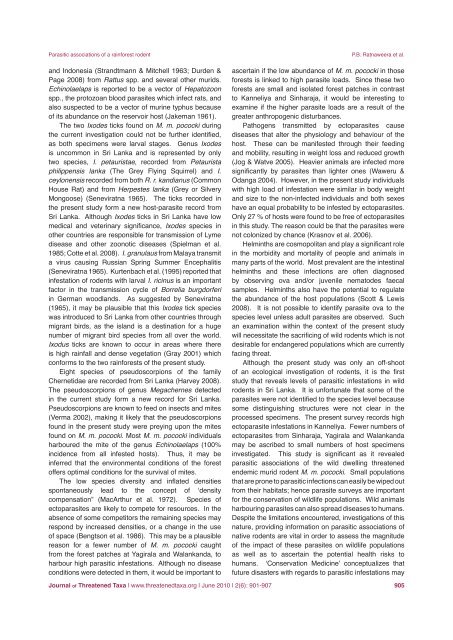Parasitic associations of a threatened Sri Lankan rainforest rodent ...
Parasitic associations of a threatened Sri Lankan rainforest rodent ...
Parasitic associations of a threatened Sri Lankan rainforest rodent ...
You also want an ePaper? Increase the reach of your titles
YUMPU automatically turns print PDFs into web optimized ePapers that Google loves.
<strong>Parasitic</strong> <strong>associations</strong> <strong>of</strong> a <strong>rainforest</strong> <strong>rodent</strong>and Indonesia (Strandtmann & Mitchell 1963; Durden &Page 2008) from Rattus spp. and several other murids.Echinolaelaps is reported to be a vector <strong>of</strong> Hepatozoonspp., the protozoan blood parasites which infect rats, andalso suspected to be a vector <strong>of</strong> murine typhus because<strong>of</strong> its abundance on the reservoir host (Jakeman 1961).The two Ixodes ticks found on M. m. pococki duringthe current investigation could not be further identified,as both specimens were larval stages. Genus Ixodesis uncommon in <strong>Sri</strong> Lanka and is represented by onlytwo species, I. petauristae, recorded from Petauristaphilippensis lanka (The Grey Flying Squirrel) and I.ceylonensis recorded from both R. r. kandianus (CommonHouse Rat) and from Herpestes lanka (Grey or SilveryMongoose) (Seneviratna 1965). The ticks recorded inthe present study form a new host-parasite record from<strong>Sri</strong> Lanka. Although Ixodes ticks in <strong>Sri</strong> Lanka have lowmedical and veterinary significance, Ixodes species inother countries are responsible for transmission <strong>of</strong> Lymedisease and other zoonotic diseases (Spielman et al.1985; Cotte et al. 2008). I. granulaus from Malaya transmita virus causing Russian Spring Summer Encephalitis(Seneviratna 1965). Kurtenbach et al. (1995) reported thatinfestation <strong>of</strong> <strong>rodent</strong>s with larval I. ricinus is an importantfactor in the transmission cycle <strong>of</strong> Borrelia burgdorferiin German woodlands. As suggested by Seneviratna(1965), it may be plausible that this Ixodes tick specieswas introduced to <strong>Sri</strong> Lanka from other countries throughmigrant birds, as the island is a destination for a hugenumber <strong>of</strong> migrant bird species from all over the world.Ixodus ticks are known to occur in areas where thereis high rainfall and dense vegetation (Gray 2001) whichconforms to the two <strong>rainforest</strong>s <strong>of</strong> the present study.Eight species <strong>of</strong> pseudoscorpions <strong>of</strong> the familyChernetidae are recorded from <strong>Sri</strong> Lanka (Harvey 2008).The pseudoscorpions <strong>of</strong> genus Megachernes detectedin the current study form a new record for <strong>Sri</strong> Lanka.Pseudoscorpions are known to feed on insects and mites(Verma 2002), making it likely that the pseudoscorpionsfound in the present study were preying upon the mitesfound on M. m. pococki. Most M. m. pococki individualsharboured the mite <strong>of</strong> the genus Echinolaelaps (100%incidence from all infested hosts). Thus, it may beinferred that the environmental conditions <strong>of</strong> the forest<strong>of</strong>fers optimal conditions for the survival <strong>of</strong> mites.The low species diversity and inflated densitiesspontaneously lead to the concept <strong>of</strong> ‘densitycompensation” (MacArthur et al. 1972). Species <strong>of</strong>ectoparasites are likely to compete for resources. In theabsence <strong>of</strong> some competitors the remaining species mayrespond by increased densities, or a change in the use<strong>of</strong> space (Bengtson et al. 1986). This may be a plausiblereason for a fewer number <strong>of</strong> M. m. pococki caughtfrom the forest patches at Yagirala and Walankanda, toharbour high parasitic infestations. Although no diseaseconditions were detected in them, it would be important toP.B. Ratnaweera et al.ascertain if the low abundance <strong>of</strong> M. m. pococki in thoseforests is linked to high parasite loads. Since these tw<strong>of</strong>orests are small and isolated forest patches in contrastto Kanneliya and Sinharaja, it would be interesting toexamine if the higher parasite loads are a result <strong>of</strong> thegreater anthropogenic disturbances.Pathogens transmitted by ectoparasites causediseases that alter the physiology and behaviour <strong>of</strong> thehost. These can be manifested through their feedingand mobility, resulting in weight loss and reduced growth(Jog & Watve 2005). Heavier animals are infected moresignificantly by parasites than lighter ones (Waweru &Odanga 2004). However, in the present study individualswith high load <strong>of</strong> infestation were similar in body weightand size to the non-infected individuals and both sexeshave an equal probability to be infested by ectoparasites.Only 27 % <strong>of</strong> hosts were found to be free <strong>of</strong> ectoparasitesin this study. The reason could be that the parasites werenot colonized by chance (Krasnov et al. 2006).Helminths are cosmopolitan and play a significant rolein the morbidity and mortality <strong>of</strong> people and animals inmany parts <strong>of</strong> the world. Most prevalent are the intestinalhelminths and these infections are <strong>of</strong>ten diagnosedby observing ova and/or juvenile nematodes faecalsamples. Helminths also have the potential to regulatethe abundance <strong>of</strong> the host populations (Scott & Lewis2008). It is not possible to identify parasite ova to thespecies level unless adult parasites are observed. Suchan examination within the context <strong>of</strong> the present studywill necessitate the sacrificing <strong>of</strong> wild <strong>rodent</strong>s which is notdesirable for endangered populations which are currentlyfacing threat.Although the present study was only an <strong>of</strong>f-shoot<strong>of</strong> an ecological investigation <strong>of</strong> <strong>rodent</strong>s, it is the firststudy that reveals levels <strong>of</strong> parasitic infestations in wild<strong>rodent</strong>s in <strong>Sri</strong> Lanka. It is unfortunate that some <strong>of</strong> theparasites were not identified to the species level becausesome distinguishing structures were not clear in theprocessed specimens. The present survey records highectoparasite infestations in Kanneliya. Fewer numbers <strong>of</strong>ectoparasites from Sinharaja, Yagirala and Walankandamay be ascribed to small numbers <strong>of</strong> host specimensinvestigated. This study is significant as it revealedparasitic <strong>associations</strong> <strong>of</strong> the wild dwelling <strong>threatened</strong>endemic murid <strong>rodent</strong> M. m. pococki. Small populationsthat are prone to parasitic infections can easily be wiped outfrom their habitats; hence parasite surveys are importantfor the conservation <strong>of</strong> wildlife populations. Wild animalsharbouring parasites can also spread diseases to humans.Despite the limitations encountered, investigations <strong>of</strong> thisnature, providing information on parasitic <strong>associations</strong> <strong>of</strong>native <strong>rodent</strong>s are vital in order to assess the magnitude<strong>of</strong> the impact <strong>of</strong> these parasites on wildlife populationsas well as to ascertain the potential health risks tohumans. ‘Conservation Medicine’ conceptualizes thatfuture disasters with regards to parasitic infestations mayJournal <strong>of</strong> Threatened Taxa | www.<strong>threatened</strong>taxa.org | June 2010 | 2(6): 901-907905
















